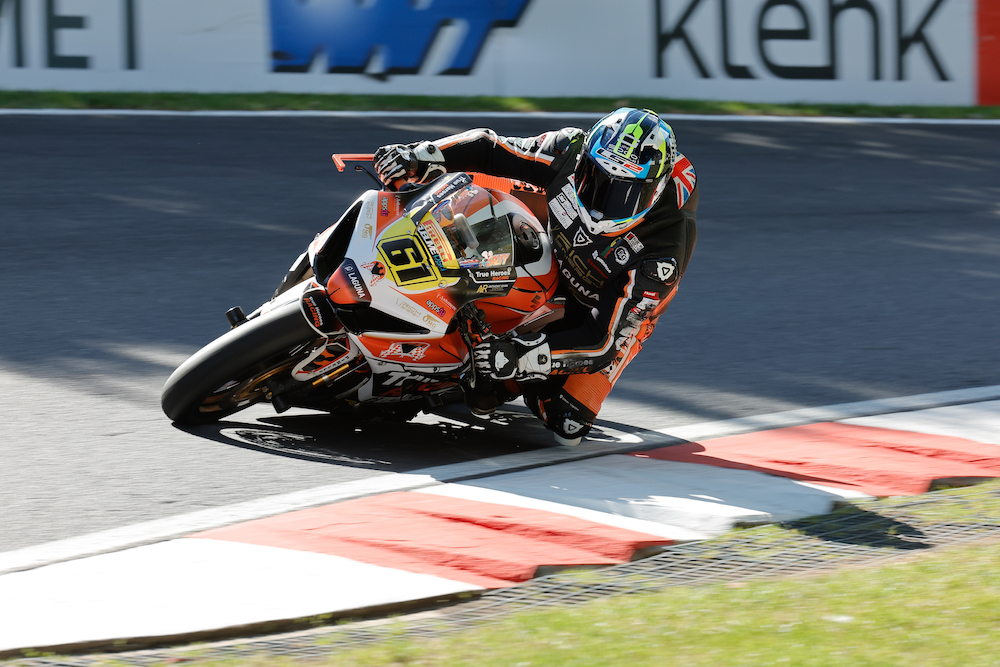True Heroes Racing and the British motorcycle racing scene

The Bikesure-sponsored True Heroes motorcycle racing team – uniquely composed of injured and sick service personnel and veterans – competes in the British Superbike Championships.
While that level represents the peak of competitive racing, this blog explains what production racing is and reveals the many other tiers available.
What is production motorcycle racing?
Production racing involves bikes you regularly see on the road and which can be bought in motorcycle showrooms. However, the race bikes are modified, to what degree will depend on which category of racing you plan to participate in.
If you go to a British or world championship superbike race you’ll see most of the following racing classes represented.
Junior Supersport/Supersport 300
Supersport 300 joined world superbikes as a support class in 2017. It offers young riders a route into the world championships.
It joined the British superbikes as a support class the following year and here it is known as Junior Supersport. It is open to riders as young as 13.
The series feature A2 licence class sports bikes ranging from 300-500cc. As all the bikes have different engine capacities, rules have been formulated permitting different rev limits, air restrictors and weight limits to ensure a level playing field.
These machines remain pretty much standard to road bikes, though features such as lights and stands are removed and race bodywork is added.
Racing footpegs and handlebars can be used and the suspension and exhaust system can be upgraded to race spec. No engine tuning is allowed and the bikes are regularly checked to ensure they conform to category guidelines.
 True Heroes 1000 Stock during the Round 8 of the 2022 Bennetts British Superbike (BSB) Championship at Snetterton 300 Circuit, Norwich, England on the 11 September 2022. Photo by Ian Hopgood
True Heroes 1000 Stock during the Round 8 of the 2022 Bennetts British Superbike (BSB) Championship at Snetterton 300 Circuit, Norwich, England on the 11 September 2022. Photo by Ian Hopgood
Superstock
Superstock racing is a breeding ground for talent and is integral to club racing. It is relatively cheap to compete because the bikes are allowed minimal adaptation from original factory spec.
There are superstock classes for 600cc aimed at younger drivers making the step up from Junior Supersport, and 1,000cc motorcycles.
Attend a 600cc race and expect to see the Yamaha YZF-R6, Kawasaki ZX-6R and Triumph Daytona 675 allowed in because it is a three-cylinder unit matching up against 600cc bikes with four.
Superstock 1000 attracts a mix of young and experienced riders. Permitted modifications mirror those permitted in Junior Supersport.
Supersport
Supersport is the main support class for superbikes and features tuned 600cc four-cylinder and 675cc three-cylinder bikes.
Chassis modifications are allowed in line with the superstock classes. Supersport engine tuning and aftermarket electronics are also permitted and that delivers more power output.
Superbike
Superbikes are based on 1,000cc sportsbikes that you can see on the streets and buy in the showroom. The rules on tuning are much more liberal than in the other race categories.The front fork externals, brake callipers, swingarm, wheels and tyres can all be replaced for racing gear. Other components such as the fuel tank can also be modified or replaced.
Engines can be race tuned increasing power to more than 230bhp. Electronics too can be modified. For the British series an ECU (engine control unit) is fitted to ensure all teams have the same level of electronic aid and no traction control.
World superbikes have more sophisticated electronics and allow traction control and engine braking systems enabling slightly faster lap times.
Prototype racing
Prototype racing involves bikes designed and built with the sole purpose of racing. They tend to be lighter, stiffer and more difficult to ride, but they are usually faster than production bikes of a similar engine capacity.
Prototype racing comines in three main categories:
Moto3
Moto3 replaced 125s as the entry level Grand Prix class usually ridden by youngsters riders beginning their race careers.
In the UK the Moto3 series is the British Talent Cup and the bikes are all identical Honda SF250Rs.
Read our blog which reveals 12 of the best 125cc motorbikes.
Moto2
The middleweight Grand Prix class uses production based 765cc, Triumph Street Triple engines in bespoke racing chassis. Moto2 runs alongside the British Supersport Championship. Race power is limited to 600cc four or 675cc three cylinder engines.
MotoGP
The main motorcycle racing class, MotoGP, is a prototype series featuring custom built 1,000cc bikes with four-cylinders, standard cylinder bore, rev limits, control tyres, a minimum weight of157kg and universal ECU.
 True Heroes 1000 stock during the Round 7 of the 2022 Bennetts British Superbike (BSB) Championship at Cadwell Park Circuit, Louth, England on the 29 August 2022. Photo by Ian Hopgood
True Heroes 1000 stock during the Round 7 of the 2022 Bennetts British Superbike (BSB) Championship at Cadwell Park Circuit, Louth, England on the 29 August 2022. Photo by Ian Hopgood
Bikesure insurance for whichever bike you ride
Whether you are lucky enough to ride a superbike or something a little more modest, Bikesure will have a bike insurance policy to match your needs.
And if you want to experience the buzz of motorcycle racing we can provide value-for-money track day cover too.
Call 0330 123 1028 for a swift no-hassle quote – or book a callback at a time that suits you.






